



Compensatory Growth
Technical Information bulletin 3 from the Canadian Poultry Industry Council. John D. Summers explains how turkeys and broilers achieve compensatory growth following a period of restricted nutrition.It is well known that animals restricted in growth due to low nutrient intake, resulting from a low quality diet or environmental or disease stress, will exhibit an increased rate of gain and enhanced feed utilization when the stress(es) are eliminated. The reason for the increased rate of gain is that the animal is smaller with respect to weight for age, and thus the tendency is for it to over-consume in an attempt to “catch-up” with respect to normal body weight for age. Since the animal will now be gaining at a faster rate, a greater percentage of nutrient intake is diverted to gain rather than maintenance, thus resulting in improved feed:gain ratio.
The important factors influencing recovery of body weight, are the severity and duration of the nutrient restriction and the age of the animal at the onset of the period of under-nutrition.
While the beef industry has taken advantage of compensatory growth for quite some time, by wintering cattle over on low quality feedstuffs and then taking advantage of cheap, plentiful, high quality spring forage, there has been little interest by the poultry industry to utilize such a feeding program.
Turkeys
Over 20 years ago work was initiated to study compensatory growth with turkeys as a means of enhancing production efficiency. Auckland et al. (1969) reported that male turkeys reduced in 6 week body weight by 25%, with the feeding of a low protein starter diet, were only 3% lighter than the controls when all birds were fed on a regular growing program from 6 to 14 weeks of age. While only a small improvement in feed utilization resulted for the test birds, a marked improvement in the efficiency of dietary protein to body weight gain for the 0 to 14 week period was noted as compared to the control fed birds.
In a further test (Auckland and Morris, 1971) male turkeys were 17% lighter when fed a 20%, as compared to a 29% protein diet from 0 to 6 weeks of age. The birds were then placed on diets varying in level of dietary protein to 20 weeks of age. The 17% lighter birds at 6 weeks of age, equaled the weight and efficiency of feed utilization of the control birds at 20 weeks of age. However, the compensatory turkeys had a 10% lower total protein intake.
An additional study (Auckland and Morris, 1971) demonstrated that turkeys fed lower protein diets during the early rearing period resulted in weight gain and carcass composition similar to that of control fed birds at 20 weeks of age. A small but non significant increase in breast muscle yield was noted for the compensatory birds.
Leeson and Summers (1978), along with a compensatory growth study, also investigated the response of heavy turkeys to diet self-selection. Both male and females fed a 20% protein diet from day one to 12 weeks of age, then placed on a regular feeding program, were significantly lighter than the control fed birds at market age (19 weeks for females, 21 weeks for males) (Table 1). However, birds given a free choice selection of a high protein diet (45.8% protein; 2464 kcal ME/kg) or a high energy diet (8.2% protein; 3348 kcal ME/kg) from day one to market age equaled or slightly exceeded the weight of the controls (Table 1). Feed:gain ratio was superior for the compensatory birds. Both the free-choice and compensatory fed birds resulted in carcasses that contained less fat and more protein (especially the females) than the control birds.
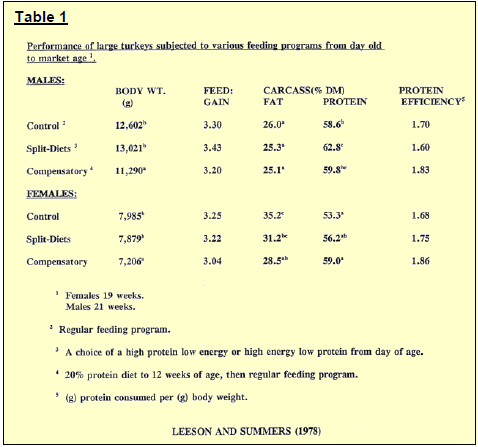
Moran (1981) fed broiler tom turkeys on several dietary treatments, varying in level of protein, to 8 weeks of age at which time all birds were placed on a similar program to 14 weeks of age. While there were difference in body weight at 8 weeks of age all treatment groups were similar in weight at 14 weeks. Carcass yield and grade differed little between the treatment groups but birds fed the higher protein diets to 8 weeks of age produced carcasses with significantly less “finish”. Since feed:gain ratios were similar for the 0-14 weeks period, it follows that efficiency of dietary protein was superior with birds fed the lower protein diets.
Oju et al (1988) fed large white male and female turkeys, from 0 to 6 weeks of age, on diets containing 75% of the protein and 66% of the lysine compared to that fed to the control birds after which time all birds received similar diets to market age (20 weeks for females and 24 for males). Body weights and carcass composition were similar for the control and test birds at market age. However, feed efficiency was marginally improved for those birds fed the lower protein diet to 6 weeks of age. Thus as reported by earlier workers the compensatory birds were significantly more efficient in utilizing dietary protein for body weight gain.
Israeli workers have also studied compensatory gain with heavy turkeys, but their approach was markedly different from that used by previous workers. They severely restricted the birds in nutrient intake for a short period at a very young age. Their data suggested that the optimal age to start restriction was 7 days of age and the optimum length of restriction was 6 to 10 days (Plavnik and Hurwitz 1988). They compared feed restriction, severe enough to just maintain weight during the restricted period, (54 kcal ME/day) or a low protein diet (7.9%) fed ad-libitum during this period. Weight gain and carcass composition were similar at 23 weeks of age while feed utilization was superior for the restricted birds (Table 2).

In a further study Plavnik and Hurwitz (1990) restricted 7 day old turkeys for 10 days, or fed a low sodium diet for this period, and compared the response to birds fed throughout on a normal feeding program. They also pair-fed a group of birds the control diet to equal the feed intake of the low sodium diet. Performance to 147 days of age confirmed the conclusions drawn from their previous study, while also demonstrating that qualitative feed restriction (low sodium diet) may also be beneficial in enhancing feed utilization and increasing breast meat yield (Table 3).
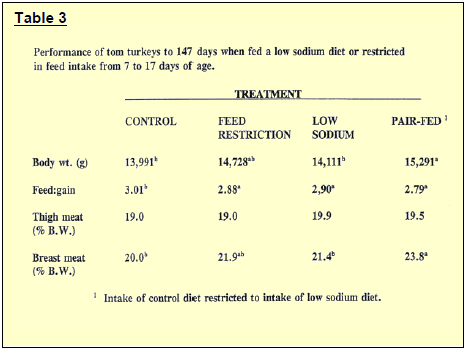
Since the pair fed group in the above study gave superior performance as compared to the more severely restricted group of turkeys, Plavnik and Hurwitz (1991), did a further test whereby the degree of restriction during the feed restriction period varieMale and female 7 day old turkeys were subjected to a restricted feeding program designed to give approximately 70, 45, or 30% of normal weightgain during a 10 day restriction period. At 17 days of age all birdswere placed on a regular feeding program to market age and compared to full-fed control birThe milder feed restriction program resulted in body weight, feed conversions, and meat yield superior to the control birds for both sexes (Table 4). These results suggest that a mild early introduced feed restriction is superior to a more severe feed restriction programmay offer economic advantages over a continuous fed heavy turkey feeding and program.
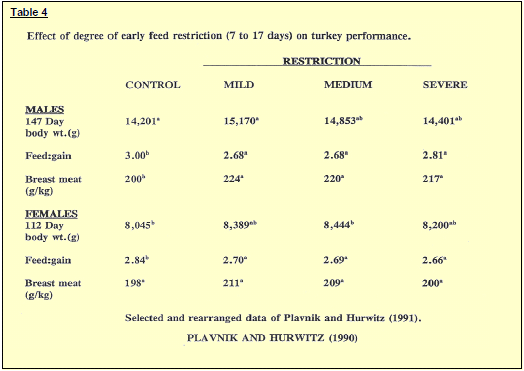
While there appears to be sufficient evidence to indicate that some type of compensatory growth program would be economically beneficial in the rearing of heavy turkeys, such practice is not in general used in turkey production today. Improvement in feed:gain ratios have been reported from .1 to .3. With an average value of .2, a savings of around 3kg of feed per bird would be achieved besides the increased weight gain and breast meat yield reported in a number of studies.
Broilers
While broilers have a relatively short growing period before marketing, as compared to most other meat animals, interest has developed in investigating whether a compensatory growth program would result in any economical or composition benefits.
Deaton et al (1973) fed broilers isonitrogenous diets containing 2 different levels of energy to 4 weeks of age. The lower energy diet resulted in birds weighing approximately 4% less than those fed the higher energy diet. By 8 weeks of age both males and females were able to overcome the growth depression when fed higher energy diets. While feed utilization was little effected by the early dietary restriction there was a significant increase in carcass fat for the compensatory birds (Table 5).
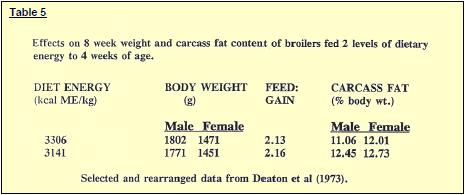
Washburn and Bondaie (1978) restricted the feed intake of broilers for 1, 2, 3, 4 or 5 weeks between the ages of 3 – 8 weeks. Restriction was carried out by alternating 24 hour feeding and non-feeding. The amount of restriction achieved with birds to 5 weeks of age was around 85% of that of the control, however, for birds older than 5 weeks little restriction in feed intake was achieved. Their data indicated that weight gain was significantly depressed with any feed restriction from 3 to 8 weeks with a similar decrease in the efficiency of feed utilization.
Moran (1979) looked at varying dietary protein levels (with isocaloric diets), during the 2 to 5 week growing period, to evaluate changes in carcass grading, after all birds received the same diet, from 5 to 7 weeks for males, and 5 to 8 weeks for females. Males receiving the lowest level of dietary protein (20%) had reduced gain to 5 weeks, but compensated during the 2 week finishing period and equaled the weight of the controls at 7 weeks of age. Carcass grading at 5 weeks of age indicated increased fat cover and decreased fleshing as dietary protein levels decreased. At 7 weeks the above affects were minimal but still noticeable. Females followed a similar pattern to males. The author interpreted the data to suggest that early diet treatment affects can have a bearing on carcass quality without altering live performance parameters.
Pokniak and Cornejo (1982) also studied compensatory growth for broilers but unlike previous workers they looked at early nutrient restriction. Male chicks were reared to 7 days or a full-fed regime, then on day 8 they were split into a control or groups restricted to 15, 30, and 45% of the feed consumption of the control birds, to 23 days of age. All birds were then full-fed to 56 days. Body, carcass, liver and digestive tract weights were lower for the restricted than the control birds at 23 days of age. However, by 56 days only the carcass weights for the 2 higher restricted groups were lighter than the controls. The author concluded that reduced performance by early nutrient restriction can be overcome by compensatory growth to 8 weeks of age providing the restriction is not too severe.
In a further study Pokniak et al (1984) again looked at early feed restriction. However, the restriction period was initiated at day of age rather than 8 days of age. Male broilers were fed either on a regular broiler program or restricted at 55% of the feed intake of the controls to either 14 or 28 days. At 14 days body weight of the restricted birds was 33% less than the controls. Birds restricted to 14 days of age equaled the body and carcass weights of the controls at 56 days (Table 6). However, the 28 day restricted group were significantly smaller. Carcass composition was similar for the 3 dietary treatments. While the feed: gain ratios were not significantly different, birds restricted for 14 days, overall, consumed 244g less feed than the controls. Such a saving would be a significant consideration in a large broiler flock.

Plavnik and Hurwitz (1985), in a series of experiments, severely restricted 7 day old broilers, for 6 up to 28 days. The birds were then placed on a regular feeding program to 8 to 9 weeks of age. All restriction treatments resulted in enhanced feed utilization and less abdominal fat at market age. However, only those birds restricted for 6 days gave body weights similar to that of the controls. The authors concluded that the lower abdominal fat was probably not due to lower energy intake, but rather the result of a reduced number of adipocytes due to the early feed restriction.
In a further study Plavnik and Hurwitz (1988) feed restriction, which resulted in just maintaining the body weights of the birds, was applied at 3 up to 11 days of age for a 7 day period. While body weight for males was similar for the various ages the restriction program was initiated, the older ages proved to be detrimental for the females (Table 7). Feed utilization was enhanced and abdominal fat reduced with all restriction treatments.
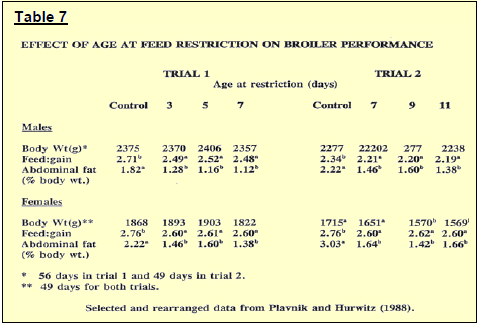
In order to reduce labour involved in implementing a daily feed restriction program, Pinchasov and Jensen (1989) studied a chemical means of feed restriction. They fed broilers from 7 to 14 days on a very restricted program, or a diet containing glycolic acid which was fed ad-libitum. While the restricted and glycolic acid fed birds were severely reduced in body weight at 21 days, by 49 days of age body weights were similar to the controls. However, slightly better feed efficiencies were noted for the restricted birds. No significant differences in carcass composition were noted between treatments.
Plavnik and Hurwitz (1990) studied the use of full-fed, low-protein and low-sodium diets to restrict early weight gain of male broilers. The test diets, along with a group pair-fed (the starter diet) to equal the feed intake of those birds receiving the low-sodium diet were fed for a 6 day period. After this time all birds were placed on the regular feeding program. Birds receiving the low-protein (9.2% protein) diet gained only 22% as much as the controls during the restriction period. Compensatory growth by the pair-fed and low-sodium resulted in body weight similar to the controls at 56 days of age (Table 8), however, there was little difference between treatments with respect to feed utilization. Abdominal fat was significantly lower for the test groups than the control birds (Table 8).
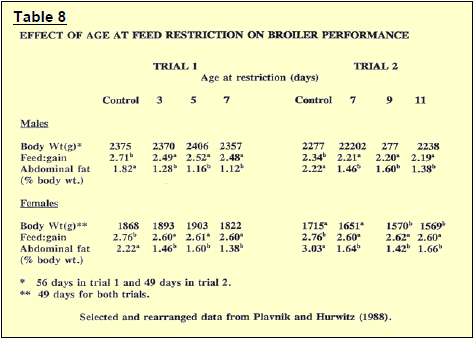
Summers et al (1990) studied early nutrient restriction of broilers (7 to 14 days) with the restricted birds receiving half of what was consumed at 7 days of age. A further treatment consisted of the control diet diluted 15% with wood fiber (alpha flock) for the 7 day restricted period. At 41 days of age birds on the control and diluted diet treatments had similar body weight while the restricted birds were significantly smaller. The same picture was noted for both males and females. As a percent of live or carcass weight, abdominal fat deposition was not different for the 3 diet treatments.
In a further test the above workers fed male broilers:
- A regular feeding program to 42 days of age.
- Birds restricted from 7 to 14 days at 75% of the feed consumed at 7 days then placed on the regular program.
- The regular program but diet protein level increased by 2% for the last week of the test.
- Similar to (c), but a poor quality protein, feather meal used in place of soybean meal.
There were no significant differences in body weight at 42 days, however, the restricted birds were lighter (Table 9). Feed:gain ratios were also similar for the diet treatments. Abdominal fat was significantly reduced for the restricted birds, those fed the diluted diet and especially for those birds fed 2% additional protein during the last week of the test. However, on an absolute basis this reduction in abdominal fat only amounted to between 5 and 10 grams.
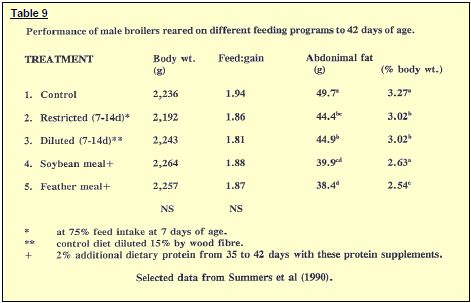
The above study suggests that even mild early feed restriction, which gave favourable results for birds processed at 7 to 8 weeks of age, may not be advantageous for 5 to 6 week old birds. It also suggests diluted diets may be utilized in place of feed restriction and this would markedly reduce labor during the restriction period. There is no question that higher dietary protein levels in the finishing ration will reduce carcass fat deposition. However, the cost involved in relation to the small reduction in abdominal fat noted would have to be evaluated.
Yu et al (1990) studied various degrees of early feed restriction by feeding reduced amounts of feed every other day (skip-a-day); once a day; or once every hour, from 8 to 14 days of age. The restricted birds while similar in body weight at 56 days, were significantly smaller than control fed birds. Body composition was unaffected by diet treatment at 56 days of age.
Plavnik and Hurwitz (1991) in a further study confirmed their earlier work in demonstrating that mild early feed restrictions can be completely overcome, with respect to body weight at 56 days and that reduced abdominal fat and improvement in feed utilization is usually achieved.
Leeson et al (1991) further studied diet dilution as a means of inducing an early weight reduction of broilers. From 4 to 11 days of age the control diet was diluted by 25, 40, or 55% with rice hulls. Body weights were similar at 42 and 56 days for the control and test birds (Table 10). Diet dilution had no effect on carcass characteristics at 42 days of age, however, by 56 days there was an indication of reduced abdominal fat with the females (Table 11.)
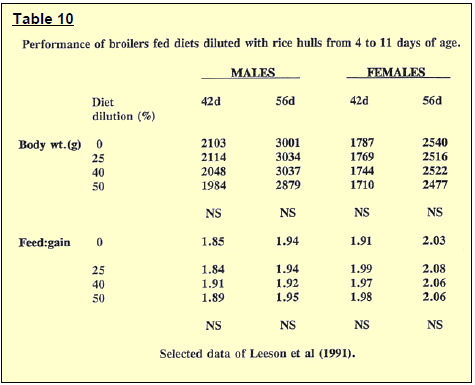

The report of Leeson et al (1992) is of interest as they studied the ability of the broiler to increase feed intake, during the later part of the growing period, in order to overcome any early growth depression or to attain optimum weight gain with diets of low nutrient density. Their data showed that broilers chicks are far from eating to physical capacity at 35 days, as diets diluted up to 50% with oat hulls resulted in 49 day body weight and carcass composition similar to regular fed birds. Previous reports had suggested that broilers, unlike leghorns, were consuming feed to near full gut capacity (Nir et al 1978, Newcombe and Summers 1984). However, most of the previously reported work was done with young birds.
October 2008







